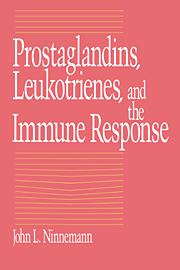Book contents
- Frontmatter
- Contents
- Foreword by James S. Goodwin
- Preface
- 1 A brief history and introduction
- 2 Prostaglandin/leukotriene structure and chemistry: a primer
- 3 Monocytes and macrophages
- 4 Lymphocyte response
- 5 Inflammation and the neutrophil
- 6 Malignancy and the arachidonic acid cascade
- 7 Tissue and organ transplantation
- 8 Rheumatoid arthritis and autoimmunity
- 9 Traumatic injury and surgery
- 10 Allergy
- Index
- Frontmatter
- Contents
- Foreword by James S. Goodwin
- Preface
- 1 A brief history and introduction
- 2 Prostaglandin/leukotriene structure and chemistry: a primer
- 3 Monocytes and macrophages
- 4 Lymphocyte response
- 5 Inflammation and the neutrophil
- 6 Malignancy and the arachidonic acid cascade
- 7 Tissue and organ transplantation
- 8 Rheumatoid arthritis and autoimmunity
- 9 Traumatic injury and surgery
- 10 Allergy
- Index
Summary
Atopic or allergic diseases affect 10–20% of the population of the United States. Genetic factors play an important role in the susceptibility to these diseases, and association with specific HLA haplotypes has been demonstrated. Allergic responses are immunological reactions mediated through the activity of IgE. As early as 1921, Prausnitz and Kustner recognized that serum from allergic individuals contained a humoral sensitizing factor, which they called reagin (1). With the advances made in immunochemistry during the 1950s and 1960s came the characterization of reaginic antibody as a fifth distinct immunoglobulin class, IgE (2). While the serum of normal individuals contains only nanogram quantities of IgE, concentrations in allergic individuals can be quite significant.
A variety of cells synthesize membrane glycoproteins that can bind the Fc portion of specific immunoglobulins, and such Fc receptor interactions initiate specific cellular functions (3). Fc receptors on mast cells and basophils have a high affinity for monomeric IgE. Human basophils normally have 103–106 of these receptors per cell; however, basophils from individuals with high levels of serum IgE have an increased number of receptors (4). As shown in Figure 10.1, the interaction of IgE with surface receptors on basophils and mast cells (as well as some other nonspecific stimuli) results in the release of biologically active mediators such as histamine (5).
- Type
- Chapter
- Information
- Prostaglandins, Leukotrienes, and the Immune Response , pp. 194 - 209Publisher: Cambridge University PressPrint publication year: 1988



